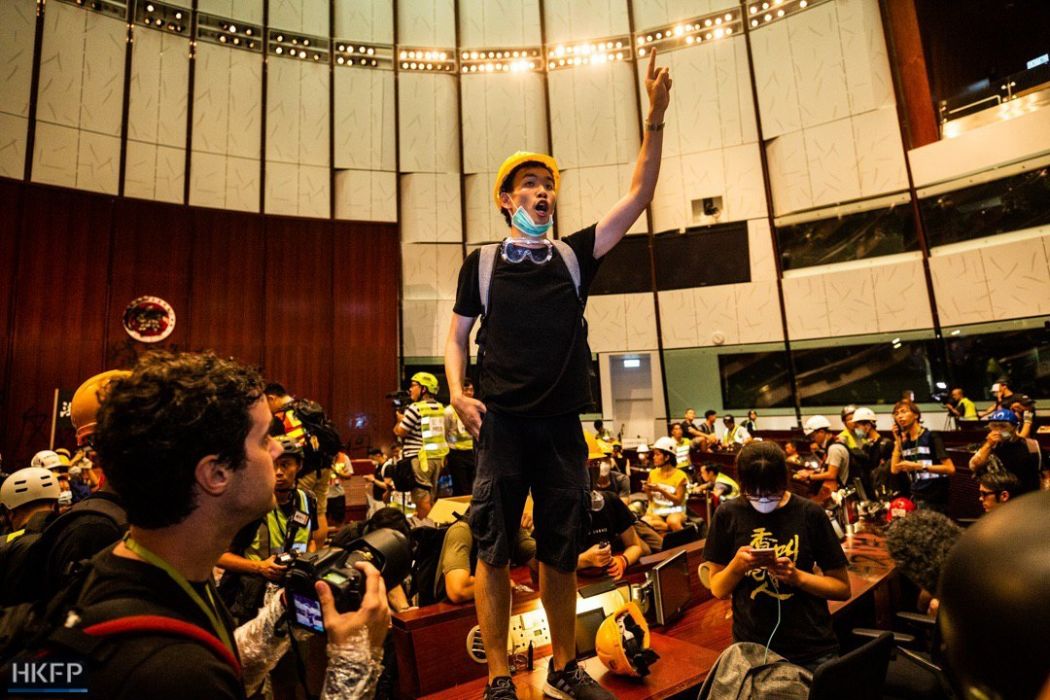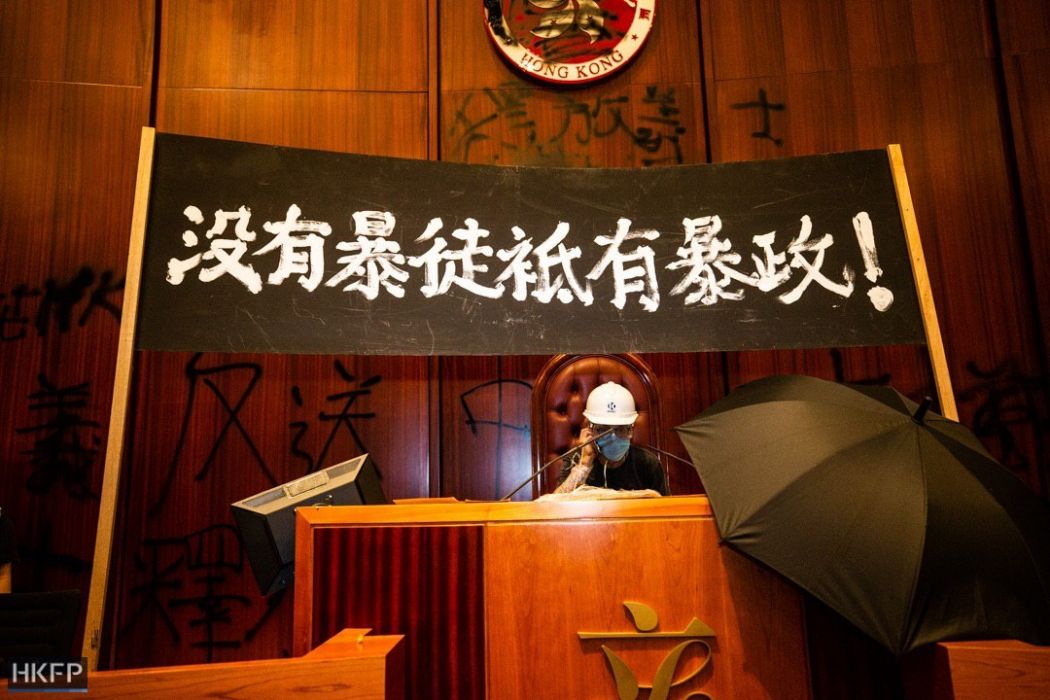There is no doubt that on the July 1 handover anniversary this year, something changed. In the city that prides itself on well organised, orderly protests, a group of young people used metal poles and stolen fences to break into the Legislative Council (LegCo) Complex. They then defaced and vandalised the main chambers of the non-representative parliament, including the HKSAR emblem, taking out “People’s Republic of China” leaving “Hong Kong Special Administrative Region” in place.
The images are indelible. A panelled wood great hall filled with young men and women in hard hats, gloves and goggles, along with face masks to hide their identity. They look like a construction crew but on closer inspection, some are destroying the decor: spray painting walls with slogans, breaking furniture, while the majority watched.

Much is made out of it, of course. Chief Executive Carrie Lam condemned it as “extreme violence.” The police chief promised to track down the culprits. The New York Times Editorial Board lectured the protesters that they have done permanent damage to the cause, giving the Chinese government an excuse to crack down.
As student leader, Joshua Wong—who had just been released from prison for his involvement in the 2014 Umbrella Movement—replied on his Twitter feed: “HKers don’t need this kind of condescension.” Nor do we need the European Union or American Chamber of Commerce making statements speaking on behalf of the “majority of Hong Kong people” about whether they supported the storming of the parliament. No one actually knows, there are many different opinions, and they are foreigners with no rights to speak for us.
The people who did use the opportunity to speak for themselves were the protesters who broke into LegCo. Brian Leung, a PhD student at University of Washington, revealed his face and read out five demands that mirrored the sentiments made during peaceful protests: the withdrawal of the extradition bill, free elections for parliamentary seats, an independent investigation on police violence, freeing of those arrested related to the protests, and for Chief Executive Carrie Lam to step down.
For those versed in resistance movements, the storming of the parliament would not be shocking or surprising. Breaking into the chambers of power—a symbolic take-over of the people from the elites—has been used countless times in many different circumstances. Last week in Georgia, thousands stormed the parliament when a Russian MP spoke. 240 people were hurt. In 2016, Shia Muslim activists stormed Iraq’s parliament in Baghdad against the deadlock to the new cabinet. The riot police also deployed tear gas to clear out the protesters.

The escalation of civil disobedience is common when the government does not heed public sentiment expressed by peaceful protests. The Umbrella Movement lasted an uneventful 79 days without achieving free elections of our leader. Two million people marched, according to the organisers—which meant over one in four of the population and the government still did not withdraw the extradition bill. Facing constant refusal, there will always be a tiny fraction of the population to radicalise: the Antifa which broke away from the Women’s March after President Trump’s election, an Agit Singh to a Gandhi, or a Malcolm X to a Martin Luther King. This process was succinctly described by the statement graffitied outside LegCo in Cantonese: “It is you who taught me that peaceful protests don’t work.”
Not to say that any of these young people who broke into the parliament are proponents of actual violent insurrection like Agit Singh and Malcolm X believed in. Breaking into parliament and destroying the property is vandalism. It may be a violent act, but not violence against people which is what actual radical “extreme violence” is. True perpetrators of violence would be the IRA in Northern Ireland or the suicide bombers for ISIS. These young protesters share no similarities to those organisations.
Some might worry that the breaking into LegCo would damage Hong Kong’s protesters’ reputation, and the cause itself. Much has been made about the civic-mindedness of our protests compared to other countries, but holding ourselves above other resistance movements did us a disservice to begin with. It removes ourselves from the context of protest history and larger social-justice movements around the world. After all, there are other less orderly, more spontaneous, messier movements that have succeeded-such as recently in Sudan-being best behaved and cleanest does not automatically lead to the most successful results. Of course, being polite and respectful should be encouraged, but it’s not an indicator to the world or to ourselves how worthy our cause is.

Paying attention to others, we might find ideas that we didn’t come up with ourselves. Due to public pressure, Macedonia MPs signed a bill giving amnesty to those who stormed their parliament in 2017, as long as the protesters did not participate in vandalism or help organise the event.
This sadly would be unlikely in Hong Kong, as the government had already used the misnomer of “extreme violence” to their advantage, trying to sway public opinion to a more pro-Beijing stance, and away from the protesters cause. Which is why, we need to be alert on how we are spoken to, who attempts to speak for us, and who controls the conversation. We have to be careful not to concentrate on the storming too much, to discuss the minutiae of the event for too long. After all, the activists who stormed LegCo’s demands reflected what the peaceful protesters wanted as well. We need to focus on those, continue with the movement, and sustain the momentum.
In the meantime, real consequences for those who participated have started. Over a dozen have been arrested. Those arrested face 10 years of jail time for rioting, not to mention extra charges that will be put forward.

Those young men and women’s lives have forever changed. Whether we are closer to achieving those goals they gave up their future for are up for speculation. The unfortunate truth is we don’t know. Jail terms have always been part of civil resistance but to vastly different outcomes. Nobel Peace Prize winner Nelson Mandela suffered 27 years in jail and after the apartheid regime fell became the president of South Africa. Chinese laureate, Liu Xiaobo, was incarcerated for over a decade and died in custody.
What will happen to those young people is heartbreaking. We can only be vigilant that their trials will be held within a fair and independent judiciary, not influenced by political pressure.
That during their time served, they will be free from mental or physical torture which is sanctioned in China, but not Hong Kong. The only way to make sure this does not happen to them is exactly what they have been fighting for; in fact, what every single peaceful protester has been asking for as well.
Which is, they will not be extradited.
